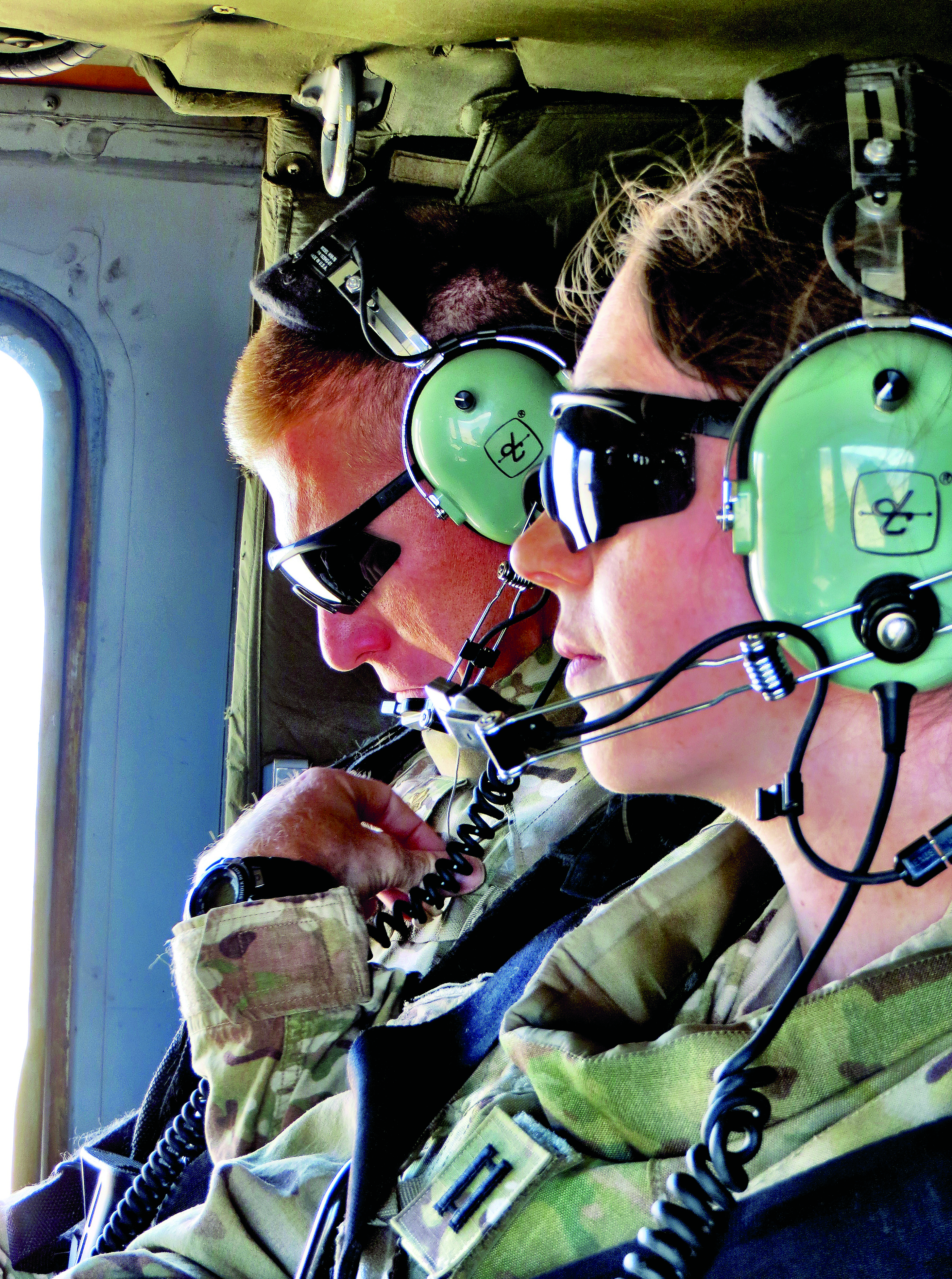
U.S. Army judge advocate CPT Catharine Parnell, right, flies to Tarin Kowt, Afghanistan, from Kandahar Airfield in 2013 as part of a joint U.S.-Australian investigative team looking into a civilian casualty incident. She was deployed as an administrative law attorney with CJTF-3, working for the 3ID Headquarters under now retired COL Randy Bagwell and LTC Nacy Alouise (Photo courtesy of CPT Catharine Parnell)
No. 2
A Day in the Life
What follows are two stories of life as a deployed judge advocate—told fifty years and nearly 3,000 miles apart
By Major Eddie Gonzalez, Major Ernie Reguly, Captain Jack Gibson, and Captain Kyle Hoffmann
Afghanistan 2018
In today’s combat environment, it is rare that a fellow military member would wonder about the need for a lawyer supporting a combat mission. Our intent is to show how, during a single twenty-four-hour period, military lawyers have become integral with modern combat deployments.
We constitute just four of the fifty-eight lawyers—U.S. and Coalition—currently serving in the Combined Joint Operations Area—Afghanistan, or CJOA-A. All support, at some level, both the NATO Resolute Support (RS) Mission and the U.S. Operation Freedom’s Sentinel (OFS). While we each deployed from different home units, we all are assigned to United States Forces-Afghanistan (USFOR-A). Our Staff Judge Advocate (SJA) is COL Eric Young, who advises the four-star general USFOR-A Commander. He is also dual-hatted as the NATO Senior Legal Advisor (LEGAD), advising the NATO RS Commander.
Between the four of us, we represent the Bars of California, Georgia, Texas, and Virginia, as well as several federal courts. We received our law training at Loyola Law School in Los Angeles, University of Georgia, Tulane, and Washington and Lee. Three of us were directly commissioned into the JAG Corps, two active duty and one U.S. Army Reserves, with the fourth receiving his commission from West Point. Two of us have prior military service: one serving for fourteen years in the U.S. Air Force and Air National Guard as a C-130/HC-130P crewmember, the other serving for three and a half years as a Medical Service Corps Officer. Three of us are married with a combined total of four children. Three of us are on our first deployment as judge advocates, and for two of us this is our first combat deployment.
While all of us perform duties outside our assigned portfolios, MAJ Eddie Gonzalez is assigned as Chief of Intelligence Law in the USFOR-A/RS legal office in Kabul; CPT Kyle Hoffmann is an Operational Law Attorney with the Special Operations Joint Task Force—Afghanistan (SOJTF-A), based out of Bagram Airfield; MAJ Ernie Reguly is the Command Judge Advocate for the Train, Advise, and Assist Command—South (TAAC-S) at Kandahar Airfield; and CPT Jack Gibson is an Operational Law Attorney in the USFOR-A/RS legal office at Bagram Airfield.
As combat deployments go, there are no off days. However, Mondays somehow still carry the same feel of the start of a new week as they do stateside. Interestingly, the day we chose for this article ultimately had several issues and incidents that crossed the path of more than one of us, as readers will discover. This was our “day in the life” in Afghanistan—Monday, 30 April 2018.
.jpg?ver=tA0RC9MV5FtlGtgAlFLnCw%3d%3d)
A Legal Assistance team poses for a photo in Kandahar, Afghanistan (Photo courtesy of JAGC’s Regimental Historian & Archivist’s office).
Chief of Intelligence Law
MAJ Eddie Gonzalez’s day began like most others by attending the daily morning intelligence brief to the USFOR-A J2/NATO RS Deputy Chief of Staff—Intelligence (a Rear Admiral, U.S. Navy). MAJ Gonzalez does not have a speaking role during this brief, he merely attends for situational awareness or to respond to any legal questions based on updates provided. The first half of this morning’s update progressed as normal, but half way through, a loud boom silenced the room and then the silence was broken by a blaring alarm notifying the USFOR-A / NATO RS Headquarters (RS HQ) that the camp was immediately locked down. The lockdown resulted from a personnel borne improvised explosive device (PBIED) detonation approximately 100 meters from the camp’s outer fence. The assessed target was an Afghan National Defense Service checkpoint—one of the many checkpoints charged with keeping Afghans and Coalition Forces, like those at RS HQ, within the Kabul green zone safe.
The incident triggered MAJ Gonzalez to depart the intelligence brief early and head to the RS HQ Strategic Operations Center (SOC). Along with his Intelligence Law portfolio, in the latter half of his yearlong deployment, MAJ Gonzalez also assumed Operational Law portfolio duties. One of those duties was to immediately seek information on significant incidents like that morning’s explosion and advise the SOC Director regarding force protection matters, as well as keeping the operational law attorneys at Bagram informed. His presence in the SOC was also to be available should the incident involve U.S. or Coalition Forces, whether as a direct result of the attack or in a base defense response. MAJ Gonzalez quickly learned that this incident was fully in the hands of Afghan authorities, so he would simply be in an observer capacity. However, within an hour of the first PBIED, a second PBIED was detonated within a few hundred yards from the first. This second explosion was further from RS HQ, but tragically it was in the middle of dozens of local journalist who had gathered to report on the first suicide attack.
While in the SOC, MAJ Gonzalez received word of a second significant incident in Afghanistan. A U.S. Soldier with the SOJTF-A had just been killed during a combat operation and another was severely wounded. MAJ Gonzalez reported the information to the SJA and coordinated with the operational law attorneys at Bagram. From his vantage at RS HQ, he was ultimately limited to supporting the subordinate legal staff at SOJTF-A as they were involved supporting this engagement and making sure the higher headquarters legal office at U.S. Central Command (USCENTCOM) was aware.
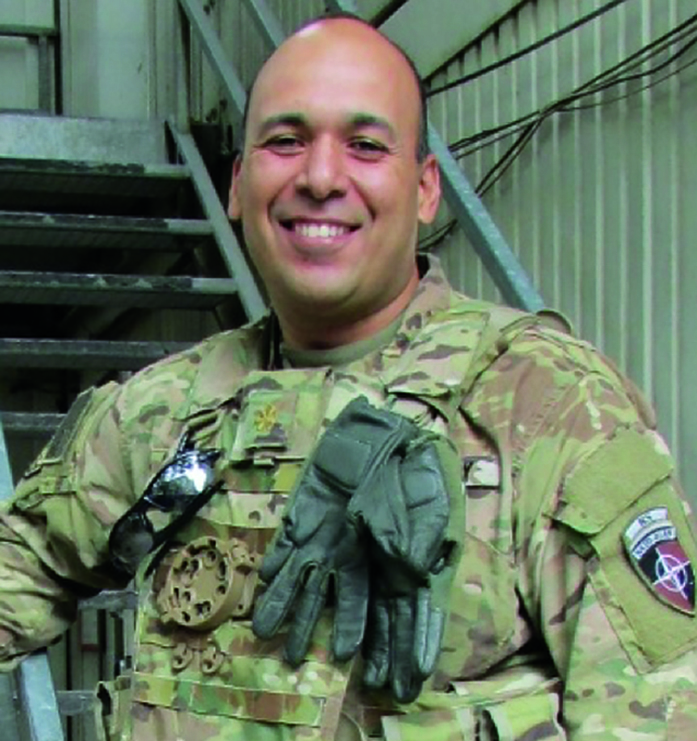
Major Eddie Gonzalez
By a little after 1000, just three hours into his morning, MAJ Gonzalez made his way to his desk for the first time that day. He had just a few minutes to check emails before attending the weekly SVTC involving the USFOR-A OSJA / RS LEGAD office and all of the subordinate legal offices in the CJOA-A. In all, fifteen different offices join in the meeting, with multiple attorneys and paralegals attending at each location. The SJA, COL Young, chairs the meeting and all outstations provide a weekly update on anything relevant for the group. It is an opportunity for everyone to get at least a brief weekly understanding of legal issues impacting the various commands across Afghanistan.
After the SVTC ended at 1100, MAJ Gonzalez headed to the Combined Joint Intelligence Operations Center (CJIOC) to follow up with a request from a Signals Intelligence (SIGINT) analyst who wanted advice on how to best present, from a legal perspective, several products that support target validation nomination packets. MAJ Gonzalez is one of the attorneys that advises the USFOR-A Target Validation Authority (TVA). The TVA reviews proposed targets for possible future kinetic engagement. The judge advocate’s role on the board is to advise the validation authority on whether the proposed target complies with the Laws of Armed Conflict (LOAC) and Rules of Engagement (ROE). That these CJIOC analysts reached out for legal support in advance was a welcome opportunity for MAJ Gonzalez to help shape targeting products on which he would eventually advise the TVA. The conversation was a fruitful one, and MAJ Gonzalez left hopeful that his job was made a little easier by these forward leaning intelligence analysts.
On his way out of the CJIOC, MAJ Gonzalez was stopped by a Joint Targeting Cell analyst, who wanted to provide him with a pre-look at one of the target packets that would be presented at that day’s TVB. MAJ Gonzalez noticed a discrepancy in some of the imaging supporting the nomination. Several Geospatial Intelligence (GEOINT) analysts were brought into the discussion, and through a collaborative effort, the cause was identified and resolved. Again, the efforts of the analysts to reach out early for legal support saved them from having that discussion in front of the two general officers during the TVB.
After lunch, MAJ Gonzalez called the legal office at Bagram to speak to Capt Mitch Altman. Capt Altman is a Marine Corps judge advocate and the USFOR-A Chief of Operational Law. MAJ Gonzalez and Capt Altman share the TVB advising duties, so MAJ Gonzalez wanted to make sure Capt Altman was informed of the two separate targeting conversations MAJ Gonzalez had prior to lunch with the intelligence analysts. They also discussed the two Kabul city PBIED attacks from that morning and the U.S. Soldier who had been killed in action. Although neither the Bagram nor Kabul legal offices had a direct role in responding to the attacks, keeping each other informed helps to provide accurate and timely advice should a response become necessary.
Following the conversation with Capt Altman, MAJ Gonzalez had a short window before a scheduled brief on the RS and OFS ROE to the Personal Security Detachment for the incoming 9th Air and Space Expeditionary Task Force—Afghanistan (9th AETF-A). A more detailed ROE brief would follow shortly after he assumes command. During the time before he provided this ROE briefing, MAJ Gonzalez reviewed a proposed Military Deception (MILDEC) Concept of Operations (CONOP) for the USFOR-A J-39. As there was not enough time to draft a written review, MAJ Gonzalez gave it an initial read and was prepared to contact the CONOP’s drafting action officer to get clarification or suggest edits. Luckily, the CONOP was relatively straightforward and no phone call was necessary.
MAJ Gonzalez then departed the OSJA and walked to the 9th AETF-A area to provide the requested ROE brief. As he had provided similar briefings for over ten months, this ROE brief went relatively smoothly. The recipients were attentive and asked plenty of thoughtful questions—about all you can ask for an audience required to attend and receive these mandatory briefings. Once complete, MAJ Gonzalez returned to his office at 1500 to make final preparations for the TVB he was about to attend. He reviewed the proposed target packets that he had earlier discussed with the JIOC intelligence analysts and Capt Altman one last time, then he made his way to the TVB. During the TVB, the attorney on the board will focus on whether the proposed targets are valid military objectives under LOAC and ROE. Thanks in part to the changes the JIOC intelligence analysts made earlier in the day, the TVB went without incident and all proposed targets were approved. The TVB lasted about an hour, then MAJ Gonzalez met up with several other members of the OSJA for dinner at the RS dining facility.
After dinner, MAJ Gonzalez called the USCENTCOM Chief of Intelligence Law. USCENTCOM is USFOR-A’s higher headquarters and is nine and a half hours behind Kabul, so most calls to counterparts in the U.S. occur in the evening. This call was driven by a discussion with CPT Hoffmann at SOJTF-A. CPT Hoffmann was dealing with an information sharing issue where guidance from CENTCOM was conflicting with guidance he was receiving internally at SOJTF-A. Because of the subject matter, MAJ Gonzalez offered to call his counterpart at USCENTCOM to clear up the discrepancy. A brief discussion on authorities gave MAJ Gonzalez the information he believed CPT Hoffmann was seeking; he relayed the information back to the SOJTF-A legal office and crossed another task off his list.
MAJ Gonzalez’s day ended with reviewing several documents that had arrived on his desk early in the day. Because of the operational tempo, routine tasks like reviewing drafts of U.S. or NATO RS Standard Operating Procedures, and drafting legal reviews of investigations or MILDEC products, are usually reserved for the late evenings when phone calls and meetings are fewer and far between. After completing enough tasks to feel that tomorrow’s leftovers would be manageable, MAJ Gonzalez was able to get on to his favorite part of his day, video calling home to his wife Megan and watching his two boys, Joey and Luke, play for a little while without a care in the world.
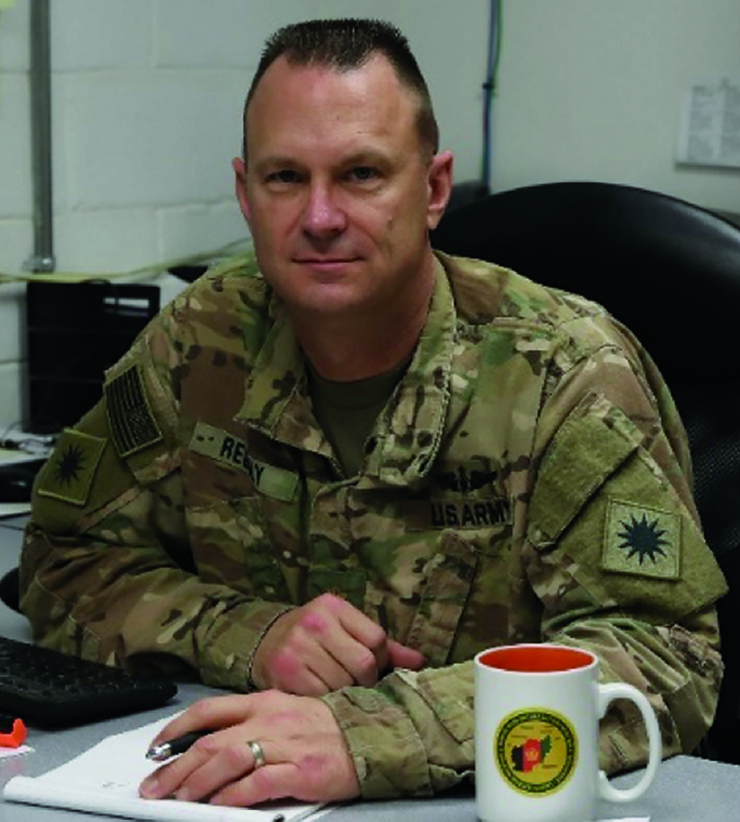
Major Ernie Reguly
Special Operations Operational Law Attorney
At SOJTF-A, the Joint Operations Center (JOC) operates twenty-four hours per day, seven days per week—so the operational law judge advocates work in twelve-hour shifts. As one of nine judge advocates serving in a special operations legal advisor billet in Afghanistan, CPT Kyle Hoffmann takes the “day” shift, covering operational law requirements from noon until midnight. However, by 1030 on a daily basis SOJTF-A forces are usually kinetic somewhere in Afghanistan, so CPT Hoffmann arrives early to review the previous night’s operations, the upcoming day’s operational priorities, and get up to speed on what has occurred in the few hours since he last left the JOC. Today, since his last shift ended, he learns that one U.S. Soldier supporting the SOJTF-A was killed and one severely wounded during a combat operation with Afghan special operations forces, and two ISIS-K insurgents wearing suicide vests had detonated themselves, killing scores of civilians.
All U.S. forces in Afghanistan are authorized to defend themselves and their unit, so judge advocates always ensure they understand when and how U.S. forces can use indirect or air delivered strikes against enemy forces located in built-up or populated areas. In this case, the U.S. and Afghan forces were taking effective small arms fire from Taliban insurgents located in adjacent buildings, and there were no assessed civilians anywhere near the structure. Both CPT Hoffmann and the subordinate Task Force judge advocate believed the air strikes were appropriate, advised their commands as such, and the buildings were destroyed.
During a break for a brief lunch, CPT Hoffmann received word that the Taliban exploded a vehicle-borne improvised explosive device (VBIED) outside of Kandahar airfield in TAAC-S’s area of operations. Later reporting indicated eleven Afghan children were killed in that attack.
After lunch, CPT Hoffmann conducted a positive hand-off with the “night” operational law attorney and officially took over the “Op Law” seat in the JOC. The JOC is comprised of four rows of tiered seating facing CineMassive screens displaying information from across the country. The operational law judge advocate has a permanent desk in the JOC, seated next to the intelligence officer for current operations, the chief of operations, and the fires officer. This team, along with the Deputy Director for Operations and the Director for Current Operations, oversees the day-to-day activities of Special Operations Forces (SOF) across Afghanistan.
Following the handoff, CPT Hoffmann met for an hour with the Director of Psychological Operations (PSYOP) to discuss whether their upcoming operations were within the current authorities. These discussions are steeped in military history, as the psychological operations officer tries to use historic precedent to justify his plans.
Once the PSYOP director left, a warrant officer knocked on the door requesting a power of attorney so his wife in Florida could get their son a military dependent identification card. In between his operational duties, CPT Hoffmann wrote the power of attorney and notarized it for the warrant officer.
By early afternoon, a CONOP arrives in CPT Hoffmann’s inbox for legal review. Each time a SOF unit conducts an operation, a judge advocate reviews the intelligence to ensure it is current, and reviews the scheme of maneuver to ensure that Coalition Forces (CF) are aware of potential protected objects and places during the operation and plan to act appropriately, and that the CF are authorized to conduct this particular operation. This CONOP involved a helicopter assault force clearing a known ISIS-K stronghold, with Afghan military forces leading the effort.
After the CONOP review, there are two lingering emails requiring immediate attention. The first is a request by the SOJTF-A Director of Future Operations asking CPT Hoffmann to review a Fragmentary Order prior to the CG signing it. This is more of an editing assignment than a legal one, but the staff trusts their judge advocates, so these quick tasks are not uncommon.
The second is an email from a Coalition Special Forces commander asking whether an operation he would like to conduct is allowed by his country’s national caveats. Special Operations Joint Task Force-Afghanistan is part of a “dual-hatted” command: it also serves as the NATO Special Operations Component Command—Afghanistan (NSOCC-A). As such, the judge advocates must be well-versed in both U.S. and NATO authorities. Each of the RS troop contributing countries release their respective “national caveats” to the overall RS mission (a list of what they are willing and unwilling to do). Each time an NSOCC-A unit plans an operation, the plan must be considered against the respective national caveats. Although the particular Coalition country of which the Coalition SOF commander was inquiring has a caveat related to this issue, they are still authorized to conduct the operation and CPT Hoffmann advises as such.
By mid-afternoon a kinetic strike request arrives on CPT Hoffmann’s desk. CPT Hoffmann quickly reviews the request, there are no LOAC or ROE concerns, so he forwards his review to the commander.
At this point in the late afternoon, the U.S. Soldier who had been killed in action that morning and the wounded service member, were medically evacuated from the firefight. To do so, the supporting U.S. aircraft and ground force commander wanted to deny the enemy the ability to fire on the approaching medevac helicopter by firing at the ground near the enemy’s location, known as a terrain denial strike, as they were still present in the village. Due to the highly restrictive ROE and concerns for civilian casualties and damage to civilian property, such strikes require judge advocate review. Quickly assessing the tactical situation, CPT Hoffmann reviewed the plan and found it legally sufficient.
Since there are two U.S. Army attorneys billeted as operational law attorneys for NSOCC-A/SOJTF-A, they split other judge advocate responsibilities—CPT Hoffmann is also the Chief of Administrative Law, and his counterpart is the Chief of Military Justice. Once per week, CPT Hoffmann provides an update on administrative investigations to the USFOR-A higher headquarters. Thankfully, there was recent progress on a lingering investigation into a Coalition Force member’s death, and two other investigations were approved by the SOJTF-A commander, so CPT Hoffmann submits those updates to the USFOR-A administrative law attorneys.
Nearing dinner time, CPT Hoffmann—who attended a class to become a military mail handler—retrieves the SOJTF-A SJA’s mail from the mailroom. It is, without doubt, his most important duty.
The NSOCC-A/SOJTF-A judge advocates—the U.S. Army SJA, the on-shift U.S. Army operational law attorney, and the U.S. Air Force fiscal law attorney—eat dinner together every night at 1800. Eating a family-style dinner with the SJA and the two on-shift captains provides a semblance of normalcy.
Following dinner, the Special Forces team that suffered the U.S. Soldier killed in action is in the process of being exfiltrated from the objective area when one of the subordinate special operations units calls to discuss whether a structure from which U.S. helicopters had received effective fire earlier in the morning could be destroyed. In the end, the Special Forces team is able to be successfully recovered from the objective location without the Afghan building being destroyed.
CPT Hoffmann then discussed an ongoing issue with the Chief of Intelligence Law at USFOR-A, MAJ Eddie Gonzalez, to determine whether one of the SOJTF-A’s units could share a PSYOP product with an Intelligence Community organization. MAJ Gonzalez had previously discussed the question with USCENTCOM, which allowed both he and CPT Hoffmann to collectively determine it was legal to do so. CPT Hoffmann passed this information on to the requesting intelligence officer.
As CPT Hoffmann also serves as the SOJTF-A Chief of Administrative Law, he is then required to draft an appointment memorandum for the required investigation into today’s combat death. This is the sixth death investigation appointment memorandum that he has written in his ten months in Afghanistan. He completes it, and sends it to the SOJTF-A SJA for his review.
Once per month, the operational law attorneys at NSOCC-A/SOJTF-A conduct an informational brief to the SOJTF-A Joint Operations Center (JOC) personnel on the current U.S. and NATO operational authorities. This is intended to ensure everyone who works on operations understands and is current on the authorities and ROE. Today’s briefing covers the RS ROE and NATO self-defense.
At 2100, the rest of the “day” shift personnel change over with the “night” shift, and there are few legal requirements as SOJTF-A waits for night operations to begin. CPT Hoffmann passes the next few hours researching and writing a “white paper” on the difference between covert action and traditional military activities to aid the command with operational decision-making.
At midnight, CPT Hoffmann’s day ends as the night shift judge advocate arrives to sit in the JOC until the morning, until CPT Hoffmann’s return.
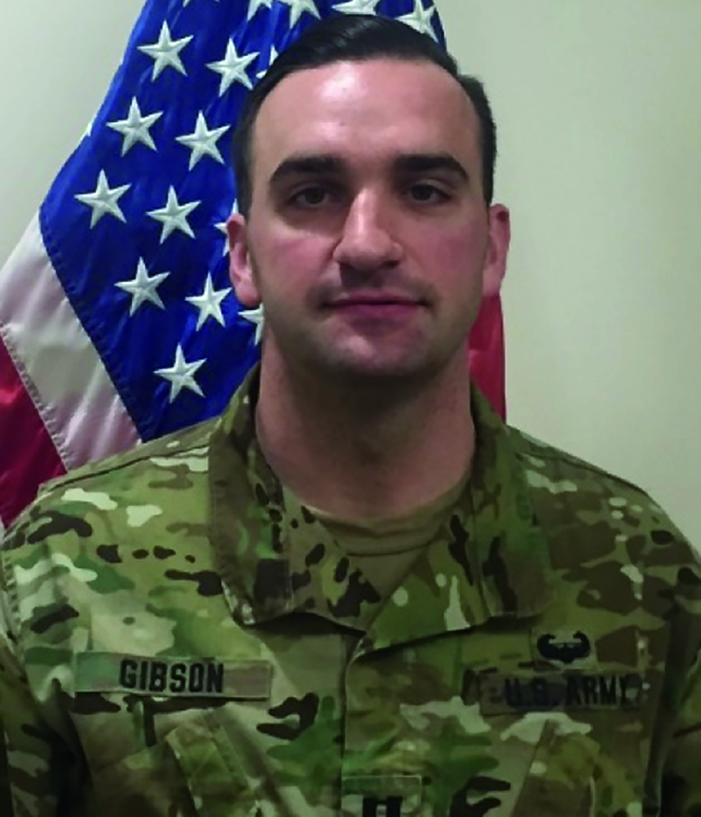
Captain Jack Gibson
Command Judge Advocate
The morning started for MAJ Reguly at around 0700 with the best part of every day, a video call to his wife Cecilia and children, Isabel and Anthony, to talk about how their day had gone and to say goodnight before they went to bed. At 0830, he walked to the TAAC-S compound and started reviewing emails that had come in overnight. The morning’s emails included one from his regular National Guard office at the division regarding a judge advocate’s annual evaluation. As an Active Guard and Reserve (AGR) member in the California Army National Guard, MAJ Reguly is the active duty Command Judge Advocate (CJA) for his installation, and the single full-time judge advocate at the division. Active Guard and Reserves are part of the organizational personnel structure that operate National Guard units between weekend drills. In Afghanistan, like at home, MAJ Reguly’s function as the CJA is to serve as the legal advisor to the division commander. However, some of the subjects that he advises on in Afghanistan are quite different.
After addressing the Soldier’s evaluation issue, MAJ Reguly moved to addressing the rest of his emails, as well as reviewing the TAAC-S situation report (SITREP) from the night prior and the daily Combined Joint Operations Center (CJOC) update. Once finished, he reviewed an updated Information Operations (IO) CONOP before it was time for the weekly LEGAD SVTC at 1030, which is attended by all U.S. and Coalition LEGAD offices throughout Afghanistan. Following the SVTC, MAJ Reguly’s office held a quick staff meeting since it is one of the few times during the week that the five attorneys and one paralegal that make up the TAAC-S legal office are together at the same time. Three of the attorneys work in different locations on TAAC-S. The OPLAW attorney, CPT Frank Bittar, works in the CJOC, and the Police Advising Team (PAT) and Military Advising Team (MAT) advisors, CPTs Donato Clay and Julian Kisner respectively, work in the main headquarters building with their respective advising teams.
At 1120, following the office staff meeting, MAJ Reguly contacted the Commanding General’s (CG) aide to confirm time on his calendar to brief the findings of an Army Regulation (AR) 15-6 investigation involving officer misconduct and the appointment of an investigating officer in another matter. After the phone call, he went to the CJ39 to discuss questions regarding the IO CONOP he had reviewed earlier. With the answers in hand, MAJ Reguly went back to his office, completed the CONOP legal review and sent it to the CJ39. While drafting the legal review, MAJ John Olson, the 2nd BCT, 4th Infantry Division judge advocate returned to the office from briefing some newly arrived Soldiers at the Joint Defense Operating Center (JDOC). At the JDOC, MAJ Olson had been advised of a Vehicle Born Improvised Explosive Device (VBIED) attack that had just struck one of TAAC-S’s Ground Defense Area’s (GDA) patrols. The VBIED driver had rammed the GDA patrol vehicles before detonating. The attack injured several Romanian soldiers, who are part of the NATO RS Coalition, killed eleven civilians and injured several others, most of whom were children. Acts like that definitely have an effect on the day, and as a parent it was difficult for MAJ Reguly not to stop and wonder what the families of those children must be going through.
Around noon, MAJ Reguly had lunch at the DFAC with a couple members of his office, a short but welcomed break from the bad news that morning. After lunch, he began preparing for a 1530 meeting with the CG, to discuss the officer misconduct investigation and separately, the appointment of an investigating officer into a potential LOAC violation.
Before his meeting with the CG, MAJ Reguly had to draft the appointment order for the investigating officer in the investigation of the potential LOAC violation. Once he finished the appointment order, MAJ Reguly had time to review the supplemental information provided by an individual who had filed a claim against the U.S. Government relating to the use of land in Afghanistan by U.S. and Coalition forces, land which he claimed to own. Much of the approximately 200 pages of information that had been provided by the claimant had previously been received, and none of the information overcame the fact that the land in question was provided by the Government of the Islamic Republic of Afghanistan (GIRoA) for use by the U.S. Government and Coalition forces. Further, any claim by the claimant would have to be presented to GIRoA for resolution. With nothing new or relevant to consider, MAJ Reguly would be able to draft a Notice of Final Action after returning from his meeting with the CG.
At the meeting with the CG, MAJ Reguly first briefed on the officer misconduct report, not a quick task as the report was about two or three inches thick. MAJ Reguly discussed his recommendations with the CG, which he took under consideration pending his review of the investigation report. Next was the appointment order for the potential LOAC violation. The CG provided some additional guidance on the matter, which would require a revised appointment order. After the meeting, MAJ Reguly returned to the office to revise the appointment order and draft the notice of final action for the land claim.
On Monday afternoons, one of the busiest Soldiers on TAAC-S is the legal office’s paralegal, SSG Andrew Marshall, who is the Soldier to see if you need a power of attorney or a document notarized. TAAC-S seems to have a never ending supply of personnel in need of those services, so the office can get busy on Monday afternoons. Unfortunately, so does MAJ Reguly’s telephone because someone listed his direct line all throughout Kandahar Airfield (KAF) as the number to call if you need these services. So between the phone calls and the constant flow of Soldiers, Sailors, Airmen, and contractors through the legal office, it takes a little extra time to get things done on a Monday afternoon.
Finally, it was time to go to the DFAC for dinner. After dinner, MAJ Reguly and MAJ Olson discussed a number of issues relating to the potential LOAC violation and the information collected regarding the incident. The unit involved had already returned to the United States so they contacted the unit’s Brigade Judge Advocate, MAJ Olson’s predecessor, to discuss the matter. After the long call to the States ended, it was time for MAJ Reguly to complete some administrative work, which included updating the weekly investigations tracker, compiling the end of month legal report that gets sent up to the RS HQ LEGAD/OSJA, and clearing out the last batch of emails that had come in. Like most U.S. personnel in Afghanistan, TAAC-S uses three different email domains and three different telephone domains to communicate, so there is a never ending supply of information to manage and things to do that fill in the gaps of each day. By about 2250, MAJ Reguly was at that point where he could start something new or go to the gym. The gym won out and then he called it a night.
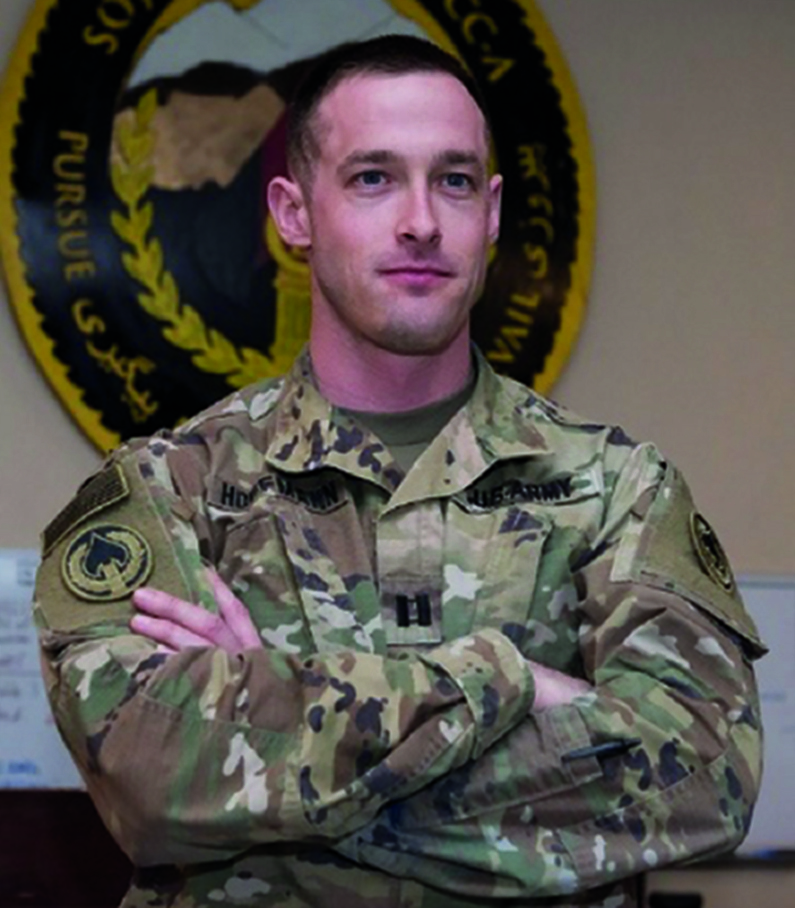
Captain Kyle Hoffmann
USFOR-A / NATO RS Operational Law Attorney
At 0728, the USFOR-A/RS Combined Joint Operations Center (CJOC) Director contacted the USFOR-A operational law section with a request for legal advice about a tactical situation involving U.S. Forces. CPT Gibson, along with Capt Mitch Altman (JA, USMC) discussed the details of the initial report. A group of SOJTF-A Soldiers, while conducting a pre-approved partnered mission with Afghan Special Security Forces, came into contact with a group of Taliban fighters in eastern Afghanistan. The initial report indicated that the partnered forces might be receiving fire from a mosque, creating a potential tactical dilemma between the right to exercise self-defense and the protected status mosques receive under the ROE and LOAC. While SOJTF-A retained operational control of the U.S. Forces on the ground and all supporting combat enablers, the USFOR-A/RS CJOC is responsible for overseeing all current operations in Afghanistan and facilitating the reallocation of assets when necessary. As such, the CJOC Director needed CPT Gibson to remain on standby to advise on the application of the ROE and LOAC in the event SOJTF-A requested assistance. After finishing his discussion with the CJOC Director, CPT Gibson manned his permanent desk in the CJOC.
CPT Gibson left the CJOC later that morning to meet with MAJ Davis, the Operations Officer for Task Force 3 Geronimo (TF 3G). TF 3G’s mission is to provide force protection for Bagram Airfield (BAF), the largest military installation in Afghanistan. In the four days since the Taliban announced its annual spring offensive on 25 April 2018, BAF received indirect fire (IDF) on three separate occasions. MAJ Davis wanted to discuss TF 3G’s available options to mitigate the IDF threat. They considered both non-lethal solutions, such as meeting with Afghan district or provincial level civic leaders and asking our Afghan military partners to conduct more frequent patrols in areas associated with IDF launch areas, and more lethal alternatives, e.g. the employment of terrain denial fires against historic rocket and mortar point of origin sites. Based on the applicable authorities, CPT Gibson advised MAJ Davis on which commanders could exercise approval authority for the potential solutions, and they also discussed the second and third order effects that each course of action might carry with it.
Immediately upon returning to the CJOC, CPT Gibson learned of a separate ongoing and fatal situation. Two, possibly linked, IED attacks had just taken place in Kabul, and the CJOC had already received reports of several civilian casualties. One of the attacks occurred just a few hundred meters away from the NATO Headquarters in Kabul (HQ RS). The CJOC was actively coordinating assets to respond to the situation, if necessary. The CJOC Director again directed CPT Gibson to remain on standby to provide operational legal advice should the circumstances evolve to require CJOC action.
During the lunch hour, CPT Gibson delivered a training presentation to approximately 100 Soldiers from 1st Stryker Brigade Combat Team, 4th Infantry Division (1/4ID), who recently arrived in Afghanistan, as part of the Joint Reception, Staging, Onward Movement, and Integration (JRSOI) training program. Over the course of a six to eight week period, which began in early April and will run through May, over 2,000 Soldiers from 1/4ID will deploy to Afghanistan. Each of these Soldiers will participate in mandatory JRSOI training to prepare them for operations in Afghanistan. The USFOR-A/RS operational law team conducts a class as a part of the JRSOI curriculum. The class covers general LOAC principles, both the NATO and U.S. specific ROE and authorities governing operations in Afghanistan, the application of and limits on self-defense, and vignettes highlighting lessons learned from recent engagements in theater. The classes are designed to be interactive in nature and provide all Soldiers an opportunity to alleviate any confusion about authorities prior to conducting any operations.
After concluding the training session, CPT Gibson returned to the CJOC to begin preparing for the daily Concept of Operations (CONOP) meeting that afternoon at 1600. The meeting, attended by a representative from every staff section, provides a forum for all subordinate commands and task forces to present their planned missions, often referred to as CONOPs, for approval. The headquarters for both RS and USFOR-A have published CONOP approval matrices, prescribing the CONOP approval authorities based on the level of risk associated with the CONOP. For every CONOP being presented, the operational law team provides a written legal review in order to confirm the correct approval authority, identify potential LOAC, ROE, or authorities concerns, and determine whether the CONOP is supportable under the existing authorities framework.
Today, five CONOPs, from four different subordinate units, were being presented. CPT Gibson conducted written legal reviews for each. One contained significant legal concerns so CPT Gibson forwarded the written legal review to the appropriate subordinate unit liaison officer (LNO) and followed up in person with the LNO to address.
LTC Pat Bryan, the USFOR-A Deputy Staff Judge Advocate and RS Deputy LEGAD, serves as the legal advisor for the CONOP meetings. After the afternoon CONOP meeting concluded, CPT Gibson briefed LTC Bryan on the three CONOPs requiring approval in preparation for their presentation that evening.
As the day began winding down, a subordinate unit judge advocate called Capt Altman and CPT Gibson to seek advice on an engagement their commander authorized that may have inadvertently caused collateral damage. The unit was still in the process of gathering details to determine whether a formal report was required based on the established information reporting requirements. However, given the significant emphasis on collateral damage and civilian casualty mitigation from the highest levels of leadership, the subordinate unit judge advocate deemed it prudent to discuss any concerns stemming from the potential incident with Capt Altman and CPT Gibson as early as possible.
Following the conversation, CPT Gibson wrapped up his work day by responding to a few outstanding emails. He then headed back to his room to speak via FaceTime with his wife, Meredith, before getting some sleep in preparation for the next day.
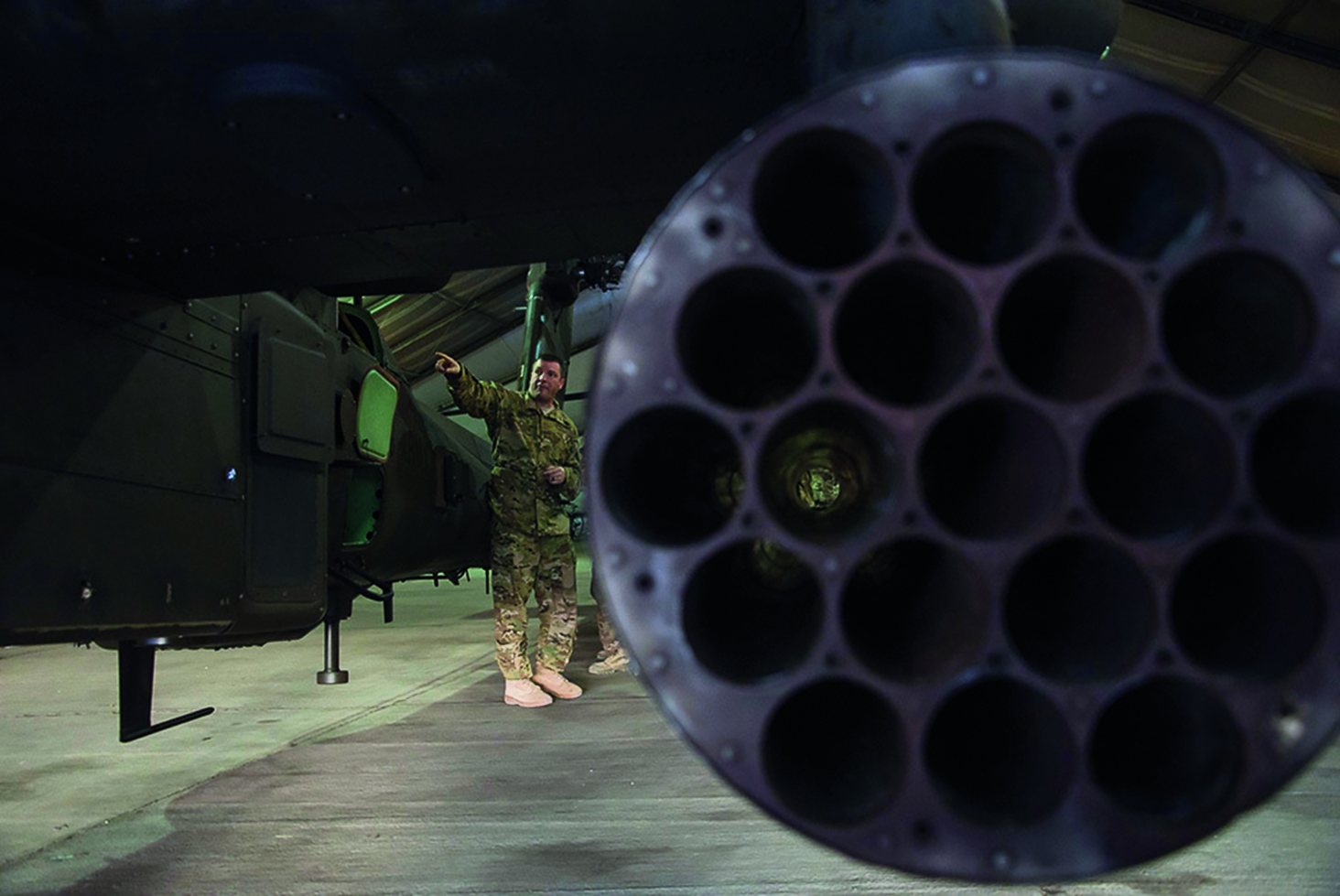
Chief Warrent Officer Joshua Kinnee, brigade safety officer and AH-64 pilot for Task Force Iron Eagle 4th Combat Aviation Brigade, 4th Infantry Division, shows judge advocate and paralegal servicemembers a UH60 Apache helicopter during a professional development class at Bagram Airfield, Afghanistan (Credit: SFC Nathan Hutchison).
Another Day Done—and Closer to Home
This was our day, 30 April 2018. It was colored, as many other days have been during the seventeen years of U.S. military operations in Afghanistan, with news of a U.S. Soldier killed in action, Coalition soldiers wounded, and many more Afghan lives taken through terror and violence. As lawyers, we did our best that day to support our fellow service members, Coalition partners, civilian teammates, and Afghan hosts. We do this all with the conviction that every effort toward a just and successful mission in Afghanistan is an effort toward not letting those lives lost that day having been in vain. Every day we complete, like this one, is one day closer to a fulfilled mission and return home to our families and loved ones. TAL